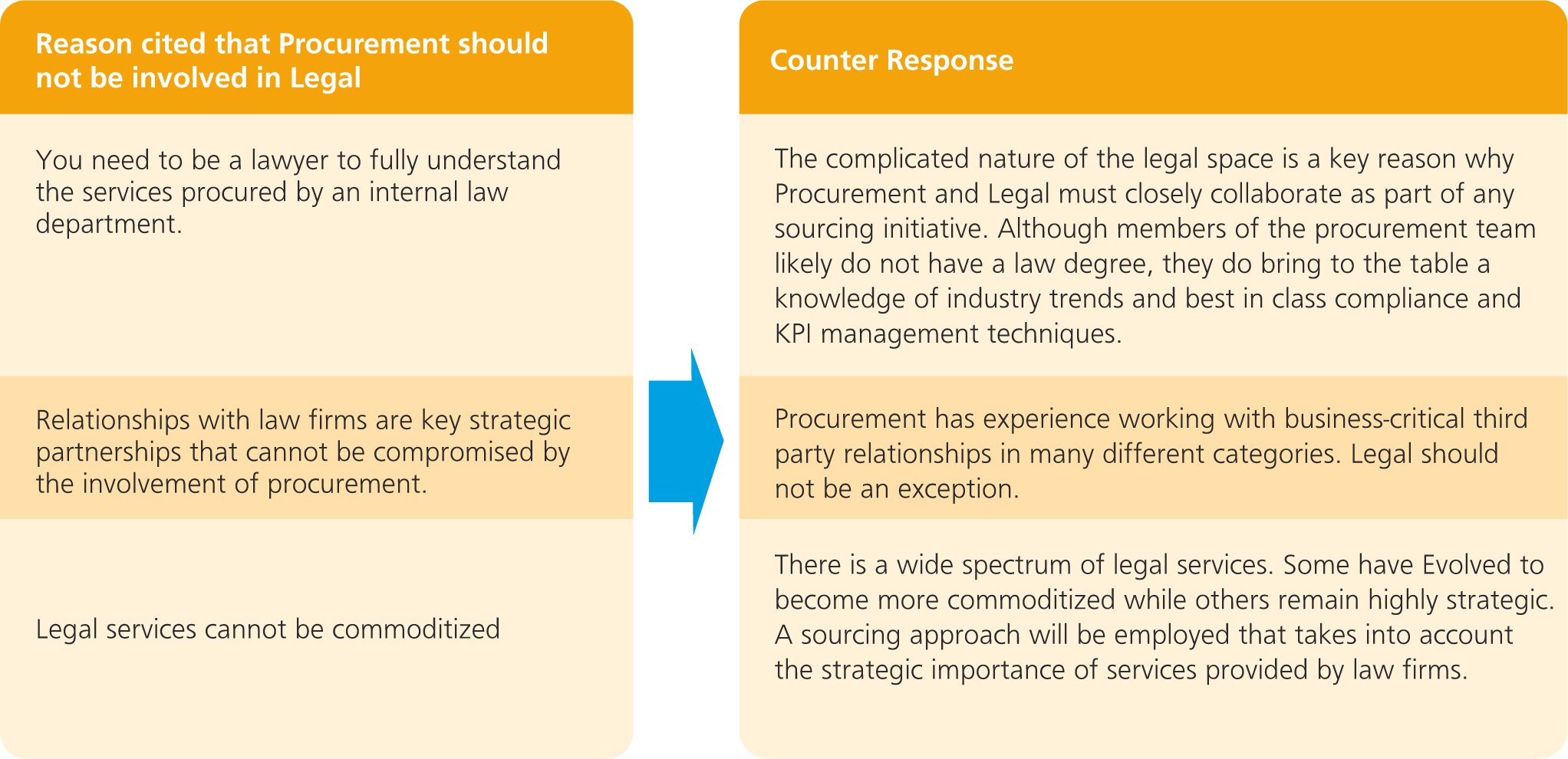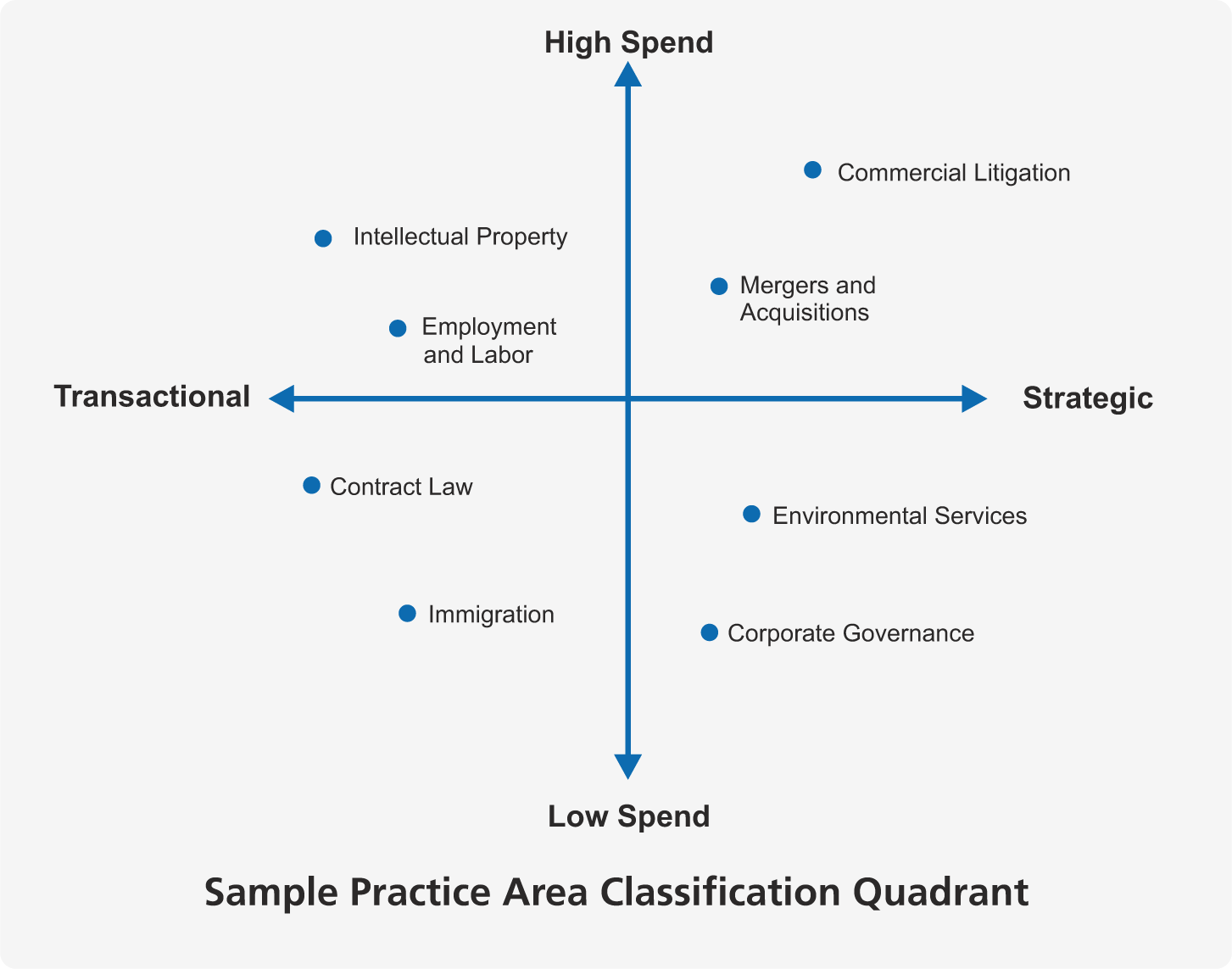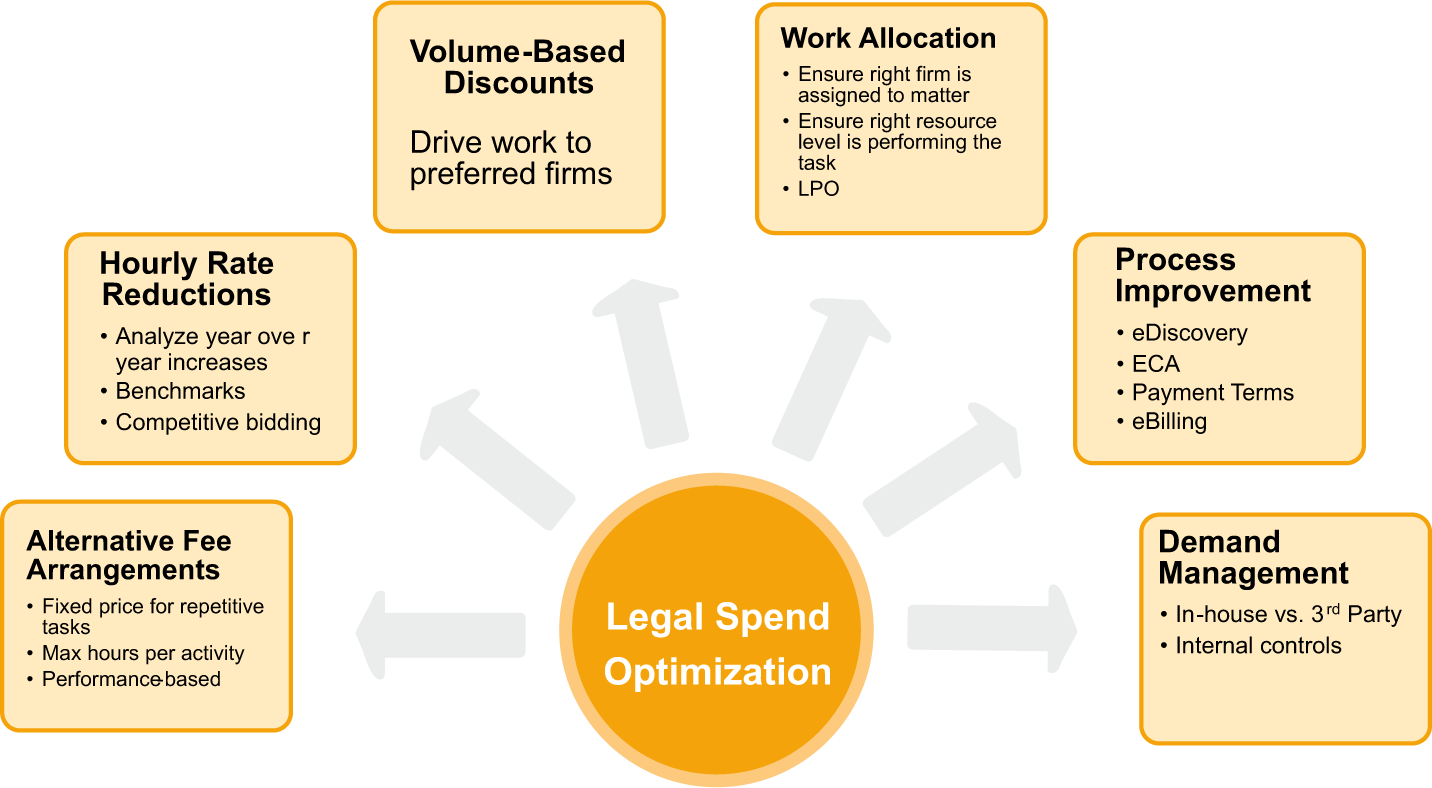Introduction
Across corporations, legal services remain one of the most elusive procurement categories. While many procurement executives have established strong control and oversight over purchasing for areas ranging from direct materials to logistics, effective management of legal spend remains a challenge. This challenge is often routed in a false perception that typical procurement strategies do not apply to a category where relationships are of the upmost importance. While the legal space certainly requires a degree of specialized procurement knowledge and understanding of category nuisances, there is the potential for significant incremental value and savings when the procurement and legal teams collaborate.
The sheer amount of spend allocated to legal services is in and of itself enough to warrant the attention of most procurement executives. Legal industry revenues in the United States exceed $250 billion annually, and in the decade prior to the economic crisis, legal spending grew at twice the rates of inflation. These substantial cost increases can be counteracted by progressive procurement strategies focused on effectively measuring the value delivered from law firms.
This paper will outline key strategies that can be leveraged by procurement leaders to successfully engage with legal professionals and drive value beyond hourly rate reductions. A procurement organization that is equipped with strong understanding of emerging industry trends and best is class engagement strategies in the legal space is well positioned to build a sustainable, mutually beneficial interdepartmental relationship.
Macroeconomic Trends
The legal services industry is in a much different state today than it was just three to four years ago. Given this evolving industry environment, there are several key market trends should be taken into consideration when determining the timing and approach for a procurement initiative.
I. Competitive Forces
The decade before the economic crisis was marked by legal services spending growth that far outpaced inflation, with firm's hourly rates increasing by over 60%. This period was followed by a multi-year contraction in legal spend and employment due to factors including economic conditions, M&A spending reductions, and a general environment of increased cost scrutiny.
Recently, industry employment has begun to rebound, but there was a fundamental shift that began to gain momentum in the post-recession period. A highly competitive environment favored law firms with competitive rates and flexible fee arrangements. This rise of these firms to some extent forced the rest of the industry to take a more progressive stance on cost structures in order to remain competitive. A consequence of this transition is a sourcing environment with a greater emphasis on value. This valuebased approach should become a focal point of any sourcing initiative.

II. Impact of technology
Technological advancements continue to evolve the way in which legal services are rendered. A range of new automated technologies intended to reduce man hours have greatly increased the efficiency with which legal firms operate.
Examples of emerging technologies ranges from software which uses predictive analytics (neural networks, probability theory, and behavioral patterns) to assist litigators in negotiating settlements, to advanced software which handles eDiscovery by mining large sets of data (e-mail and digital records) for relevant case information. eBilling is also a commonly used mechanism to streamline the payment process and ensure ongoing compliance to negotiated rates.
When approaching a legal department from a holistic perspective, these technological trends have forced procurement professionals to increase category scope from billable rates and into the realm SAAS. At the very least, a detailed review of a firm's technological-related capabilities should be included as a core qualitative evaluation metric.
III. Globalization
Globalization and low country sourcing has had a definitive impact on legal work allocation. Although less than 1% of lawyers' fees in the United States are outsourced, emerging trends will likely cause this percentage to grow substantially in the coming decade. Outsourcing presents an attractive alternative to paying high associate or paralegal rates for routine tasks. Many law firms have a pre-existing framework which allows for the outsourcing of specific functions while other organizations have selected to engage with third-party outsourcing firms directly. When outsourcing legal functions in the US, it is important to bear in mind that certain tasks require accreditation by the American Bar Association.
In leveraging globalization to further a value-based approach, is important decouple those highly strategic legal functions which have an impact on the competitive position of an organization from legal work that is transaction in nature. Provided accurate volume estimates can be established, transactional work such as patent filing can be outsourced to a low cost, offshore firm. In doing so, it is important for procurement organizations to have a strong grasp historical spending patterns to ensure that the transition away from legacy billing structures to fixed fee arrangement are driving measurable savings.
Procurement Approach
A clearly defined approach and value proposition is essential when a procurement department is looking to make inroads into the legal services category. Internal resistance typically stems from a belief that procurement lacks the necessary industry expertise and is more suited to oversee “commoditized” categories such as MRO and raw materials. This resistance can be counteracted by combining strong procurement and supplier management fundamentals with an understanding of legal billing structures and the potential value derived from alternative fee arrangements. This next section outlines strategies for gaining internal advocacy along with strategies for defining scope and conducting an evaluation of third-party firms through a RFP process.
Gaining internal advocacy requires an ability to engage with lawyers and provide a clear case for the value added by procurement. Below are some typical reasons cited as to why the procurement team should not be involved in legal sourcing matters along with potential responses.
When engaging with legal teams, it is also important to bear in mind the high degree to which legal professional hold their relationships with outside counsel. Simple tactics such as avoiding referring to legal firms as “suppliers” can go a long way in establishing credibility and respect.

Definition of Scope
A prioritization framework is an important tool in defining which legal practice areas will be addressed at which point in time. In the interest of building advocacy, commencing with those areas that are less business-critical can prove an effective approach. As part of this process, spend levels should also be taken into account.
At the bottom is a quadrant which outlines a potential classification of practice areas based on level of spend and strategic impact to core business operations. The order of these practice areas is intended to serve as an example, as the arrangement can change depending on the client industry and the corporation's business strategy. Spend analysis and stakeholder interviews are the two most important steps in segmenting practice areas in this format. Once the quadrants are populated for a specific corporation, the following steps can be taken to advance a structured sourcing initiative.
Establish Credibility through Quick Wins - The practice areas deemed “Transactional” are typically candidates for outsourcing or fixed fee arrangements as they entail functions in which the deliverable can be well defined and provided in a consistent manner from a variety of capable firms. Legal departments are typically more receptive to a standard sourcing process for these practice areas, presenting an ideal inroad for procurement.
Benchmark Hourly Rates for Strategic Practice Areas – Most legal spend is still a function of the hourly billing structure. Procurement should benchmark the current hourly rates for highly strategic practice areas such as commercial litigation and M&A. Oftentimes a sourcing initiative initially focused on hourly rate reduction can drive substantial savings while simultaneously opening the door for more progressive billing approaches.
Introduce Value-Based Fee Structures – Now that the procurement team has built confidence and identified tangible savings, the opportunity now presents itself for a more strategic role through the establishment of value-based billing structures. Helping to enable these arrangements requires a more detailed understanding of internal legal requirements and 3rd party firm deliverables. The ongoing engagement of procurement also becomes even more critical as these arrangements must often be adjusted on a case-by-case basis.
Once the project scope has been defined, the selection of firms to include in a RFP and the development of qualitative evaluation material are both processes in which close collaboration between legal and procurement is essential. The procurement team can certainly bring best practices to the table in evaluating the capabilities and risk of third-party law firms; however, the greatest value will likely reside in the procurement organization's understanding of progressive cost structures and other value-based approaches.

Quantitative Evaluation through a Value-Based Approach
Overview – There is a clear trend is the legal services industry away from the hourly bill rate. This antiquated model is difficult to track and creates inherently misaligned incentives between client and customer. At the forefront of progressive legal sourcing initiatives is an emphasis on alternative fee arrangements. Although alternative fee arrangements only accounted for less than 25% of big firms' revenues in 2012, there is definitive transition in the direction of these agreements, particularly as law firms come under increased cost pressure in a more competitive, post-recession environment. These arrangements can take many forms across practice area, but the overarching theme is paying for value delivered instead of hours consumed. Procurement should consider the following alternative billing arrangements when establishing a cost structure for third-party law firms.
Risk Collar – Applicable across practice areas, this approach allows for sharing in overruns as well as savings within a predetermined budget. Change orders can also be introduced beyond the initial budget to ensure that incremental costs are properly monitored
Blended Hourly Rates – Also applicable across practice areas, this rate structure establishes a fixed hourly rate for a particular matter regardless of resource type, encouraging the legal firms to optimize internal work allocation and enabling cost predictability and stability for the customer
Holdback/Contingent/Success Fee – Most common in litigation, this strategy utilizes aggressively discounted hourly rates with a true-up at the end of the matter that is based on pre-defined outputs
Flat Fees – Flat-fee arrangements can most commonly be found in the intellectual property space, but the concept of a predefined price for a predefined result is becoming more common across practice areas
Aborted Transaction Discount – Primarily applicable in the M&A space, under this approach a law firm provides a discount on their accrued fees if a deal does not close
In addition to the alternative fee agreement outlined above, there are a series of other strategies that can be employed to optimize legal spend. Additional optimization tactics include:
Volume-Based Discounts – Procurement should establish incentive structures under which progressively increasing rebates are applied as the level of spend with a law firm increases
Demand Management – Procurement should pose and act upon the following question – “are certain functions current allocated to third-party firms that could be conducted more efficiently and cost effectively with internal legal resources? “
Work Allocation – Procurement should draw upon its understanding of each awarded law firm's capabilities to ensure that work is being allocated to the most capable and cost effective partner on an ongoing basis

Conclusion
There was a point in time when legal services were perceived as the “final frontier” of procurement. Emerging trends across successful procurement departments both large and small indicate that this frontier is being quickly settled. Industry conditions are much different than they were 5 to 10 years ago. A structured approach to segmenting and progressively addressing all legal practice areas presents procurement with the opportunity to drive meaningful process improvements and savings. The fundamental approach, analysis and strategy that a procurement team brings to the table can be augmented by knowledge of category specific trends and alternative billing structures focused on measuring value. Building trust with a legal department is a progressive process that must be grounded in a respect for the critical function which this department provides. Once this trust is established, a collaborative partnership between the procurement and legal teams has been shown deliver substantial ongoing benefits.

